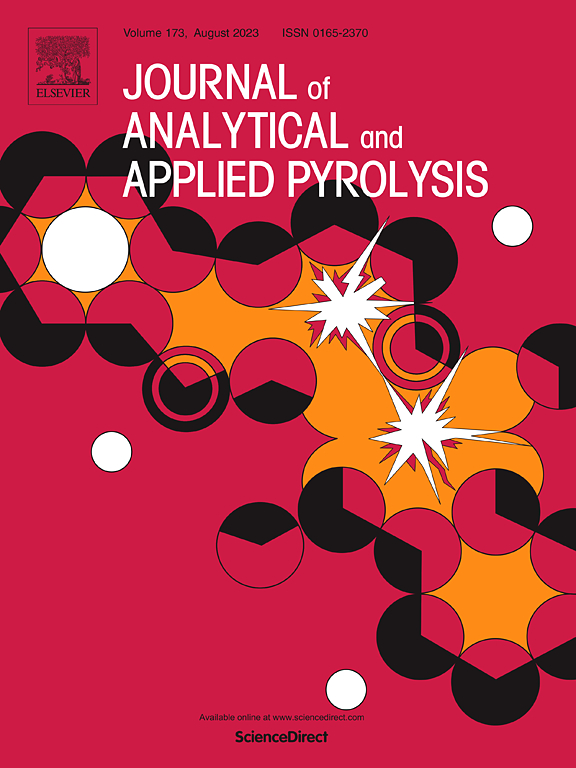通过改变糖苷键解理来裁剪废木屑衍生的多孔碳:孔结构机制分析及其在超级电容器和染料去除中的应用
IF 6.2
2区 化学
Q1 CHEMISTRY, ANALYTICAL
引用次数: 0
摘要
生物质木屑衍生多孔炭的孔隙结构的精确调控是传统活化工艺的一个重大挑战。在此,我们提出了一种分子水平的策略,通过调节糖苷键的裂解能力来精确调节孔结构。通过分析醋酸诱导h3po4活化生物质木屑的热解行为,以及热解固体产物的表面官能团,从分子水平上揭示碳材料孔隙结构调控的机制。醋酸诱导促进生物质木屑中纤维素和半纤维素的糖苷键的裂解,导致糖基化小分子的形成。这些分子与H3PO4及其衍生物相互作用,形成更多的磷-生物聚合物复合物碳化物,促进多孔碳介孔结构的发展。乙酸诱导的h3po4活化生物质木屑制备的ACPA-3样品具有优异的比表面积(2072 m2/g)、中孔体积(1.04 cm3/g)和微孔体积(0.61 cm3/g)。在0.5 a /g下,其比电容高达284 F/g,所组装的ACPA-3//ACPA-3对称超级电容器的能量密度为6.89 Wh/kg,功率密度为290.78 W/kg。此外,该样品对RhB染料具有较高的吸附量(1678.8 mg/g),去除率为96.33 %,吸附过程符合准二级动力学模型。该研究为从生物质木屑中环保合成高效储能材料和高附加值染料吸附剂提供了有价值的见解。本文章由计算机程序翻译,如有差异,请以英文原文为准。
Tailoring waste sawdust-derived porous carbon through varying glycosidic bond cleavage: Analysis of pore structure mechanism and applications in supercapacitors and dye removal
Precise regulation of the pore structure in biomass sawdust-derived porous carbon constitutes a significant challenge in conventional activation process. Herein, we propose a molecular-level strategy to precisely modulate pore structures by regulating the cleavage ability of glycosidic bonds. The pyrolysis behavior of acetic acid-induced H3PO4-activated biomass sawdust, as well as the surface functional groups of the resulting pyrolysis solid products, were analyzed to reveal the mechanism underlying the pore structure regulation of carbon materials at the molecular level. Acetic acid induction facilitates the cleavage of glycosidic bonds in cellulose and hemicellulose within biomass sawdust, leading to formation of glycosylated small molecules. These molecules interact with H3PO4 and its derivatives to form more phospho-biopolymer complex carbides, which promotes the development of porous carbon mesoporous structures. The sample ACPA-3 prepared with acetic acid-induced H3PO4-activated biomass sawdust demonstrates an excellent specific surface area (2072 m2/g), mesopore volume (1.04 cm3/g), and micropore volume (0.61 cm3/g). It is exhibited a high specific capacitance of 284 F/g at 0.5 A/g, and the assembled ACPA-3//ACPA-3 symmetric supercapacitor achieved an energy density of 6.89 Wh/kg and a power density of 290.78 W/kg. In addition, this sample had a high adsorption capacity for RhB dye (1678.8 mg/g) with a removal efficiency of 96.33 %, and the adsorption process was in accordance with the pseudo-second-order kinetic model. This study provides valuable insights for the environmentally friendly synthesis of high-efficiency energy storage materials and high-value-added dye adsorbents from biomass sawdust.
求助全文
通过发布文献求助,成功后即可免费获取论文全文。
去求助
来源期刊
CiteScore
9.10
自引率
11.70%
发文量
340
审稿时长
44 days
期刊介绍:
The Journal of Analytical and Applied Pyrolysis (JAAP) is devoted to the publication of papers dealing with innovative applications of pyrolysis processes, the characterization of products related to pyrolysis reactions, and investigations of reaction mechanism. To be considered by JAAP, a manuscript should present significant progress in these topics. The novelty must be satisfactorily argued in the cover letter. A manuscript with a cover letter to the editor not addressing the novelty is likely to be rejected without review.

 求助内容:
求助内容: 应助结果提醒方式:
应助结果提醒方式:


